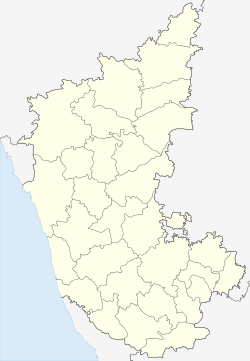- Chandravalli
-
ChandravalliLocation Coordinates 14.209°N 76.386°E / 14.209°N 76.386°ECoordinates: 14.209°N 76.386°E / 14.209°N 76.386°E Period Satavahana Country India Region Karnataka Area 0.5 km2 (0.19 sq mi) Chandravalli is an archaeological site located in the Chitradurga district of the state of Karnataka, India.[1] The region is a valley formed by three hills, Chitradurga, Kirabanakallu and Cholagudda.[2] It is a semi-arid region with scrub vegetation with a stream running through it.[3] Excavations at Chandravalli have revealed earthen pots, painted bowls and coins of Indian dynasties like Vijayanagar, Satavahana and Hoysalas as well as denarii of Roman emperor Augustus Caesar and a coin of the Chinese Han dynasty Emperor Wu Ti belonging to 2nd Century B.C.[2][4]
Contents
Excavation history
Chandravalli was first excavated by R. Narasimhachar who was the Director of Department of Archaeology and Museums of the Mysore state.[2][5] Further excavations were carried out by H. M. Krishna in 1928-29 and finally by Mortimer Wheeler under the guidance of the Archaeological Survey of India in 1947.[2]
Findings
Two distinct periods; megalithic and Satavahana were noticed during the excavations. It was found that Chandravalli was inhabited from Iron Age onwards. The inscriptions found in the nearby hillocks belonged to the Chalukya and Hoysala period, with one belonging to the king Mayurasharma, the founder of the Kadamba dynasty.[2]
General layout
The total measurement of the site excavated was 730 m × 730 m, and the general layout of the site contained a housing complex with walls of bricks, covered stone drains, red-gravel rammed floors and fireplaces made of bricks.[2] It was also a mortuary site.[3]
Earthen ware
The earthen ware found included megalithic pottery, painted vessels coated by a russet coloured wash (Russet-coated painted ware), red and black coloured ware as well as rouletted ware.[2] The paintings on these wares were linear and geometric and consisted of criss-cross, dotted lines, hatched triangles and other patterns. The shapes of these wares were vessels with funnel-shaped lid, carinated bowls, three-legged vessels and other forms.[2]
Coins
Coins of the following Indian kings were found: Krishnaraja Wodeyar III of Mysore, Krishnadevaraya of Vijayanagar, various Satavahana kings and Viraraya of Hoysala kingdom. Among the foreign coins found were denarii of Augustus Caesar and a coin of the Chinese Han dynasty Emperor Wu Ti.[2]
Other objects
Other objects found included neoliths, a cist with a skeleton in it, pots containing bones and teeth of animals and a Roman bulla. One of the cists also appeared to contain the legs of a sarcophagus.[2]
Notes
- ^ "In and Around Chitradurga". Webpage of the Chitradurga district. http://www.chitradurga.kar.nic.in/tourspot.html. Retrieved 2008-03-11.
- ^ a b c d e f g h i j Amalananda Ghosh (1990), p97
- ^ a b Peter Neal Peregrine, Melvin Ember, Human Relations Area Files Inc. (2001), p367
- ^ S. Krishnaswami Aiyangar (1995), p343
- ^ "introduction". Directorate of Archaeology & Museums, Government of Karnataka. http://kannadasiri.kar.nic.in/archaeology/eng/introduction.htm. Retrieved 2008-03-11.
References
- Aiyangar, S. Krishnaswami (1995) [1995]. Some Contributions of South India to Indian Culture. Asian Educational Services. ISBN 8120609999.
- Ghosh, Amalananda (1990) [1990]. An Encyclopaedia of Indian Archaeology. BRILL. ISBN 9004092625.
- Peter Neal Peregrine, Melvin Ember, Human Relations Area Files Inc. (2001) [2001]. Encyclopedia of Prehistory. Springer. ISBN 0306462621.
Categories:- History of Karnataka
- Former populated places in India
- Archaeological sites in Karnataka
Wikimedia Foundation. 2010.

